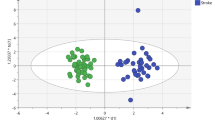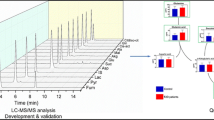Abstract
In this study, we develop a fast and convenient method for the detection of 18 types of free amino acids in the serum of ischemic stroke patients. We use high performance liquid chromatography-diode array detector and thermo C18 column to separate 6-aminoquinolyl-N-hydroxysuccinimidyl carbamate-derivatized amino acids. We find that Gln, His, Gly, Arg, and Cys levels are significantly lower in the serum of ischemic stroke patients comparing with normal persons. Our data indicate that this simple method can be used to detect free amino acids in serum with accurate and reliable results. This study provides a basis for the clinical treatment of ischemic stroke patients and suggests that amino acids can be supplemented to the patients during clinical treatment, which may improve patient prognosis.


Similar content being viewed by others
References
Hamidon, B. B., Abdullah, S. A., Zawawi, M. F., Sukumar, N., Aminuddin, A., & Raymond, A. A. (2006). A prospective comparison of percutaneous endoscopic gastrostomy and nasogastric tube feeding in patients with acute dysphagic stroke. Medical Journal of Malaysia, 61(1), 59–66.
Yoo, S. H., Kim, J. S., Kwon, S. U., et al. (2008). Undernutrition as a predictor of poor clinical outcomes in acute ischemic stroke patients. Archives of Neurology, 65(1), 39–43.
Hammarqvist, F., Andersson, K., Luo, J. L., et al. (2005). Free amino acid and glutathione concentrations in muscle during short-term starvation and refeeding. Clinical Nutrition, 24(2), 236–243.
Venkatakrishna, K., Kartha, V. B., Pai, K. M., Krishna, C. M., Ravikiran, O., Kurian, J., et al. (2003). HPLC-LIF for early detection of oral cancer. Current Science, 84, 551–557.
Reddy, Indira, Sherlin, Herald J., Ramani, Pratibha, et al. (2012). Amino acid profile of saliva from patients with oral squamous cell carcinoma using high performance liquid chromatography. Journal of Oral Science, 54(3), 279–283.
Williams, F. N., et al. (2009). Modulation of the hypermetabolic response to trauma: temperature, nutrition, and drugs. Journal of the American College of Surgeons, 208(4), 489–502.
Jiang, Z., Wu, W., et al. (2002). Enteral Nutrition (2nd edn.). Beijing: People’s Medical Publishing House.
Tang, Sung-Chun, Arumugam, Thiruma V., Cutler, Roy G., et al. (2007). Neuroprotective actions of a histidine analogue in models of ischemic stroke. Journal of Neurochemistry, 101(3), 729–736.
Bae, O. N., & Majid, A. (2013). Role of histidine/histamine in carnosine-induced neuroprotection during ischemic brain damage. Brain Research, 1527, 246–254.
Ralph, D. M., Robinson, S. R., Campbell, M. S., & Bishop, G. M. (2010). Histidine, cystine, glutamine, and threonine collectively protect astrocytes from the toxicity of zinc. Free Radical Biology and Medicine, 49(4), 649–657.
Guoyao, Wu, Bazer, Fuller W., Davis, Teresa A., et al. (2009). Arginine metabolism and nutrition in growth, health and disease. Amino Acids, 37(1), 153–168.
Choe, C. U., Atzler, D., Wild, P. S., et al. (2013). Homoarginine levels are regulated by l-arginine: Glycine amidinotransferase and affect stroke outcome: Results from human and murine studies. Circulation, 128(13), 1451–1461.
Padilla-Martin, K., Baltazar-Rendon, B., Gonzalez-Maciel, A., et al. (2009). Effects of glycine on electrical and histological properties of a rat peripheral nerve injury model. Ulus Travma Acil Cerrahi Derg, 15(2), 103–108.
Kodama, D., Ono, H., & Tanabe, M. (2011). Increased hippocampal glycine uptake and cognitive dysfunction after peripheral nerve injury. Pain, 152(4), 809–817.
Hong, Dai, Zongcai, Zhang, & Xinshen, Zhang. (2004). Determination methods of amino acids analysis. Leather Science and Engineering, 14(3), 39–43.
Acknowledgments
We thank Weijun Kang for the assistance with preparation of the experiments. We thank all the patients involved in the study.
Conflict of interest
The authors declare no conflicts of interest.
Author information
Authors and Affiliations
Corresponding author
Rights and permissions
About this article
Cite this article
Xie, Y., Li, Z. Determination of 18 Types of Amino Acids in the Serum of Ischemic Stroke Patients by High Performance Liquid Chromatography-diode Array Detector Derivatized with 6-Aminoquinolyl-N-hydroxysuccinimidyl Carbamate. Cell Biochem Biophys 73, 111–115 (2015). https://doi.org/10.1007/s12013-015-0648-y
Published:
Issue Date:
DOI: https://doi.org/10.1007/s12013-015-0648-y




